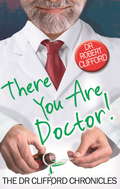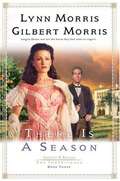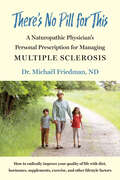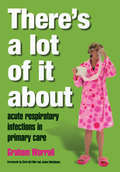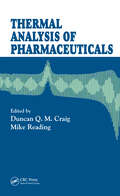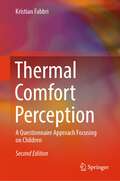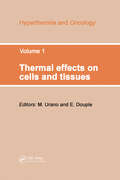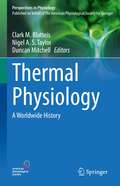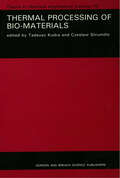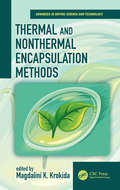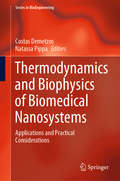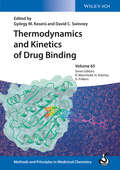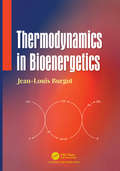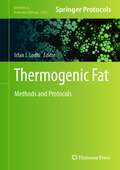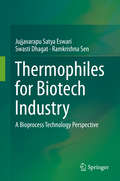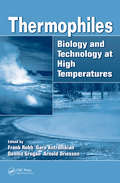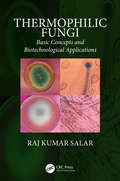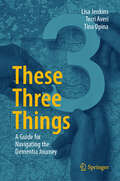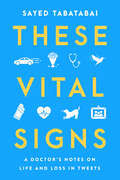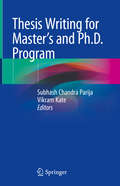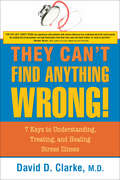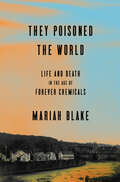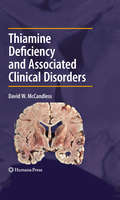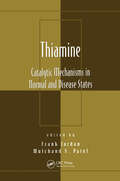- Table View
- List View
There You Are, Doctor! (The Dr Clifford Chronicles)
by Dr Robert CliffordAs charming as he is entertaining, Dr Robert Clifford dispenses a delightful dose of hilarious anecdotes, colourful portraits of patients, family and friends, tempered with heartwarming tales of human courage and tragedy.There's the eccentric hermit Hamish Richardson; the stubborn Romany Zackovitch Hebden; Miss Peabody, the elderly spinster ever hopeful of a pools win; and William Jessop, the blind man whose handicap obviously isn't a handicap! As well as stories from his Tadchester surgery, Dr Robert Clifford tells of his son's accident on Sark and there are more fishy tales with water bailiff John Denton and a sparkling of delightful descriptions of holidays at home and abroad.Doctor, family man, humourist, philosopher and counsellor, Dr Robert Clifford's stories are a tonic for us all.
There is a Season (Cheney and Shiloah: The Inheritance #3)
by Gilbert Morris Lynn MorrisA. holiday in the warm environs of Florida comes as an answer to prayer to Cheney and Shiloh Irons- Winslow. New York City is experiencing a brutal winter, and the demands of Cheney's medical practice have nearly overwhelmed her. So they set sail on Shiloh's clipper, Locke's Day Dream, and head to Sangria House, a gracious mansion in old St. Augustine. Arriving wet and cold in the middle of a rainstorm, they find the house locked and deserted; obviously no preparations have been made to receive them. But they decide to make the best of it and settle in with good grace and humor in anticipation of a relaxing time together.... Then they make a horrifying discovery, and Cheney and Shiloh immediately suspect foul play. Sangria House was supposed to be a place of rest and renewal. Instead, it seems to be harboring disturbing secrets. SOLVING THE CRIME, WITHOUT FALLING VICTIM THEMSELVES, WILL REQUIRE ALL THE RESOURCES THEY CAN MUSTER.
There's No Pill for This: A Naturopathic Physician's Personal Prescription for Managing Multiple Sclerosis
by Michaël Friedman"I truly recommend There&’s No Pill for This because it contains the wisdom of a health care professional who also has the experience of being a patient."—Bernie Siegel, MD, author of No Endings, Only Beginnings and Love, Medicine & MiraclesFrom a doctor living with MS: how to radically improve your quality of life with diet, hormones, supplements, exercise, and other lifestyle adjustmentsMost of us take for granted the little things in life—like walking out to the mailbox, socializing with friends, or enjoying a mug of hot coffee. But what if each daily activity required intensive planning and effort? That&’s what living with multiple sclerosis is like, and author Michaël Friedman knows this from first-hand experience.Since his diagnosis of multiple sclerosis a decade ago, Dr. Friedman has been searching for a cure for the disease. After years of research, he realized that he had some of the answers right in his naturopathic medicine toolbox, and others, surprisingly, lay in the realm of conventional medicine. There&’s No Pill for This tells his story and offers treatment advice and hope to those who suffer from MS. He does not promise a miracle cure but instead provides the personal prescriptions he follows that are delaying the disease process and radically improving his quality of life, including dietary measures and supplements to support a healthy microbiome and hormone therapies that can reduce neuroinflammation and possibly promote neurorestoration. Dr. Friedman presents a daily protocol for MS patients, including diet, supplement, detoxification, and hormone strategies; mindfulness therapy; physical therapy; and a wide range of beneficial lifestyle adjustments related to exercise, sleep routines, time management, stress management, and more. He also offers special advice for supporting healthy bladder and bowel function and improving oxygen supply.In the book&’s conclusion, Dr. Friedman reflects on what this complicated chronic disease has taught him, and continues to teach him, about the value of humility and about what is truly important in life.
There's a Lot of it About: v. 2, Private Life
by Chris Del Mar Graham Worrall Sir Liam DonaldsonThis book contains forewords by Chris Del Mar and James Hutchinson respectively - Dean, Faculty of Health Sciences and Medicine, Bond University, Australia; Chief of Infectious Diseases Control, Memorial University of Newfoundland, Canada. Acute respiratory infections make up a quarter of all primary care consultations. This book is the ideal quick reference and teaching aid. In presenting best evidence on the epidemiology, causes and management of the most common acute respiratory infections, this book gathers together a wealth of previously scattered original research and information and offers solutions for practical application. It is concise, clear and easy to use. Primary care professionals, including doctors, nurses and health visitors will find it invaluable, as will general practitioners in training. 'There is much more to these diseases than most of us realise. It will not take you long to find fascinating and useful material here. It makes for a very interesting read. The evidence about management, as well as diagnosis, is very important. Acute respiratory infection is one of the famously important areas in which mistaken beliefs by not only our patients, but also us doctors, of the benefits of antibiotics makes to the contribution of bacterial resistance. Graham Worrall has highlighted new forms of treatment we often forget when we reach for the pad to write another 'safety' prescription for antibiotic. There is a wealth of information here.' - Chris Del Mar, in his Foreword. 'An objective, thoughtful treatment of a subject that accounts for a large part of a primary care physician's working life but inexplicably little of his or her training. Thorough evaluation of the literature, often exposing huge gaps in the study of these extremely common conditions, will serve as an impetus for study and a guide to rational decision-making. The straightforward approach with excellent practical distillations of the evidence and resulting recommendations is perfect for the busy physician or busy student. As someone who teaches medical students about infections I have longed for a concise resource to support my efforts at encouraging prudent antibiotic prescription for respiratory tract infections. I long no more.' - James Hutchinson, in his Foreword.
Thermal Analysis of Pharmaceuticals
by Duncan Q. M. CraigAs a result of the Process Analytical Technologies (PAT) initiative launched by the U.S. Food and Drug Administration (FDA), analytical development is receiving more attention within the pharmaceutical industry. Illustrating the importance of analytical methodologies, Thermal Analysis of Pharmaceuticals presents reliable and versatile charac
Thermal Comfort Perception: A Questionnaire Approach Focusing on Children (Springerbriefs In Applied Sciences And Technology Ser.)
by Kristian FabbriThis book offers a comprehensive exploration of children's understanding and experiences of thermal comfort. The book provides a methodology for evaluating comfort that takes into account the unique perspectives of children. The first part of the book provides an overview of the history of thermal comfort, the human body and environmental parameters, and common thermal comfort indexes. It also offers guidelines for creating questionnaires that accurately assess children's perceptions of indoor thermal comfort. The book then delves into children's understanding of the concepts of comfort and energy, as well as the factors that influence their perception of these concepts. It addresses the psychological and pedagogical aspects of thermal comfort judgment, as well as the architectural and environmental characteristics that contribute to children's perceptions of comfort. First published as Indoor Thermal Comfort Perception, this updated edition also includes new sections on architecture and sensitivity, exploring the impact of classroom spaces on learning, and outdoor education and thermal comfort outdoors, based on qualitative research. These additions provide valuable insights for future studies on these topics. While physical parameter measurements and comfort indexes are useful in thermal comfort, the book emphasizes the importance of ergonomic assessments in the form of questionnaires, which offer unique insights into children's experiences. The book fills a critical gap in understanding children's perceptions of thermal comfort and is essential reading for HVAC engineers, architects, environmental psychologists, and researchers in the medical and cognitive fields.
Thermal Effects on Cells and Tissues
by M. Urano E. DoupleVolume 1 of Thermal Effects on Cells and Tissues covers Hyperthermia and Oncology. This is a collection of eight essays.
Thermal Physiology: A Worldwide History (Perspectives in Physiology)
by Duncan Mitchell Clark M. Blatteis Nigel A. S. TaylorThis edited volume records the critical historical developments in thermal physiology and makes them accessible to new and senior thermal biologists and scientists in related fields. Readers will discover how the discipline developed all over the world. Contributions from 14 different countries recollect all prominent discoveries, starting in the 18th century. Like other volumes of the Perspectives in Physiology series, this book reveals the people behind these discoveries. The authors also set the scenes in which the research was conducted in their countries. From geopolitical frameworks to new technologies and extraordinary personalities - this volume shows that scientific progress is influenced by many, often unforeseeable, factors. The history of thermal physiology not only is a story about individual outstanding scientists, but a testament for open collaboration and international comradery.
Thermal Processing of Bio-Materials (Topics in Chemical Engineering)
by Tadeusz Kudra Czeslaw StrumilloAs a result of developments in biotechnology, bioengineering, and related sciences, processing of bio-materials and bioproducts has become an area of strategic importance. Written in a textbook style, this book attempts to bring together both the theory and practice of thermal processing of bio-materials. The authors describe the principal techniques such as freezing, chilling, membrane concentration, evaporation, drying, and sterilization and their own research experiences, including degradation of thermo and xerolabile bio- products.
Thermal and Nonthermal Encapsulation Methods (Advances in Drying Science and Technology)
by Magdalini KrokidaEncapsulation is a topic of interest across a wide range of scientific and industrial areas, from pharmaceutics to food and agriculture, for the protection and controlled release of various substances during transportation, storage, and consumption. Since encapsulated materials can be protected from external conditions, encapsulation enhances their stability and maintains their viability. This book offers a comprehensive review of conventional and modern methods for encapsulation. It covers various thermal and nonthermal encapsulation methods applied across a number of industries, including freeze drying, spray drying, spray chilling and spray cooling, electrospinning/electrospraying, osmotic dehydration, extrusion, air-suspension coating, pan coating, and vacuum drying. The book presents basic fundamentals, principles, and applications of each method, enabling the reader to gain extended knowledge. The choice of the most suitable encapsulation technique is based on the raw materials, the required size, and the desirable characteristics of the final products.
Thermodynamics and Biophysics of Biomedical Nanosystems: Applications and Practical Considerations (Series in BioEngineering)
by Costas Demetzos Natassa PippaThis book highlights the recent advances of thermodynamics and biophysics in drug delivery nanosystems and in biomedical nanodevices. The up-to-date book provides an in-depth knowledge of bio-inspired nanotechnological systems for pharmaceutical applications. Biophysics and thermodynamics, supported by mathematics, are the locomotive by which the drug transportation and the targeting processes will be achieved under the light of the modern pharmacotherapy. They are considered as scientific tools that promote the understanding of physicochemical and thermotropic functionality and behavior of artificial cell membranes and structures like nanoparticulate systems. Therefore, this book focusses on new aspects of biophysics and thermodynamics as important elements for evaluating biomedical nanosystems, and it correlates their physicochemical, biophysical and thermodynamical behaviour with those of a living organism.In 2018, Prof. Demetzos was honored with an award by the Order of Sciences of the Academy of Athens for his scientific contribution in Pharmaceutical Nanotechnology.
Thermodynamics and Kinetics of Drug Binding
by Gy Rgy Keser David SwinneyThis practical reference for medicinal and pharmaceutical chemists combines the theoretical background with modern methods as well as applications from recent lead finding and optimization projects. Divided into two parts on the thermodynamics and kinetics of drug-receptor interaction, the text provides the conceptual and methodological basis for characterizing binding mechanisms for drugs and other bioactive molecules. It covers all currently used methods, from experimental approaches, such as ITC or SPR, right up to the latest computational methods. Case studies of real-life lead or drug development projects are also included so readers can apply the methods learned to their own projects. Finally, the benefits of a thorough binding mode analysis for any drug development project are summarized in an outlook chapter written by the editors.
Thermodynamics in Bioenergetics
by Jean-Louis BurgotThermodynamics in Bioenergetics aims to supply students with the knowledge and understanding of the critical concepts and theories that are needed in the biochemistry and bioenergetics fields. Biochemical reactions highlighting thermodynamics, chemical kinetics, and enzymes are addressed in the text. Author, Jean-Louis Burgot, guides the reader through the starting points, strategy description, and theory results to facilitate their comprehension of the theories and examples being discussed in the book. Also discussed in the text are the notions of Gibbs energy, entropy, and exergonic and endergonic reactions.
Thermogenic Fat: Methods and Protocols (Methods in Molecular Biology #2662)
by Irfan J. LodhiThis volume presents a broad collection of state-of-the-art methods to study the biology of thermogenic fat using in vitro cell culture and animal models. Chapters guide the readers through protocols on differentiation of human pluripotent stem cells and murine adipocyte precursors; methods for measuring mitochondrial respiration, heat generation, brown fat activation, and effects on energy metabolism in mice; and techniques for AAV-mediated gene delivery, transplantation of adipose tissue, isolation of adipose tissue immune cells and extracellular vesicles, and mass spectrometry-based profiling of brown fat lipids. Written in the format of the highly successful Methods in Molecular Biology series, each chapter includes an introduction to the topic, lists necessary materials and methods, includes tips on troubleshooting and known pitfalls, and step-by-step, readily reproducible protocols. Authoritative and cutting-edge, Thermogenic Fat: Methods and Protocols aims to be comprehensive guide for researchers in the field.
Thermophiles for Biotech Industry: A Bioprocess Technology Perspective
by Swasti Dhagat Jujjavarapu Satya Eswari Ramkrishna SenThermophiles and hyperthermophiles exhibit great biotechnological potential, as they can be utilized in processes which require higher temperatures. This book comprehensively deals with all the aspects of thermophiles, starting from the source of these organisms to their latest applications. In addition it presents a compilation of all compounds produced by various thermophilic microorganisms. Due to their application in everyday life, the demands of enzymes that can work at higher temperature have been increasing. In order to keep pace with the increasing demand the industries have to search novel thermophiles producing their product of interest. Hence, this book will be of value for industries working on various biochemical products produced by these thermophiles as well as for scientists and research scholars working on microbiology and products derived from microorganisms.
Thermophiles: Biology and Technology at High Temperatures
by Frank Robb Garabed Antranikian Dennis Grogan Arnold DriessenWe might think of them as living on the very edge of existence. Referred to as extremophiles, these microorganisms exhibit the most radical capacity for adaptation in those harsh environments that are just barely conducive to the existence of cellular life. Unlocking the mechanisms and understanding the evolutionary development that allows these si
Thermophilic Fungi: Basic Concepts and Biotechnological Applications
by Raj SalarThis book aims to fill the gap by documenting thermophilic fungi discovered over the past five decades. The chapters spans from covering basic aspects, taxonomy and classification including molecular phyologeny and biotechnological applications of thermophilic fungi.
Thermophilic Microbes in Environmental and Industrial Biotechnology
by Jennifer Littlechild Tulasi Satyanarayana Yutaka KawarabayasiThe existence of life at high temperatures is quiet fascinating. At elevated temperatures, only microorganisms are capable of growth and survival. Many thermophilic microbial genera have been isolated from man-made (washing machines, factory effluents, waste streams and acid mine effluents) and natural (volcanic areas, geothermal areas, terrestrial hot springs, submarine hydrothermal vents, geothermally heated oil reserves and oil wells, sun-heated litter and soils/sediments) thermal habitats throughout the world. Both culture-dependent and culture-independent approaches have been employed for understanding the diversity of microbes in hot environments. Interest in their diversity, ecology, and physiology has increased enormously during the past few decades as indicated by the deliberations in international conferences on extremophiles and thermophiles held every alternate year and papers published in journals such as Extremophiles. Thermophilic moulds and bacteria have been extensively studied in plant biomass bioconversion processes as sources of industrial enzymes and as gene donors. In the development of third generation biofuels such as bioethanol, thermophilic fungal and bacterial enzymes are of particular interest. The book is aimed at bringing together scattered up-to-date information on various aspects of thermophiles such as the diversity of thermophiles and viruses of thermophiles, their potential roles in pollution control and bioremediation, and composting.
These Three Things: A Guide for Navigating the Dementia Journey
by Lisa Jenkins Terri Averi Tina OpinaA dementia diagnosis can be terrifying and debilitating, but this unique book can provide caregivers—whether they are family members or professionals—with practical and simple tools to effectively address behavior and communication issues that may occur when providing care to those with dementia. These Three Things takes everyday situations (dressing, hygiene, meals, etc.) and looks at them from the perspective of a person with dementia with the goal of improving communication between patient and caregiver and minimizing undesirable behaviors. Each scenario is clearly outlined, followed by three practical action steps that a caregiver can utilize to solve the problem at hand, regardless of where the person is in their dementia journey. While caregiving can be very rewarding, it is also important that caregivers take time to check in with themselves and their needs, a chapter on caregiver stress with suggestions for self care is also included. This book can be a starting point for education on dementia, or it can be used as an intervention. Written by three experts in elder care, These Three Things gives caregivers choices that they can easily make in the moment for common issues as well as encouraging creative problem solving in all other situations not covered in the text. The authors’ approach to caregiving comes from within. Caregiving does not always have to have a high financial cost, nor does it always require large time commitments, as many of the suggestions in this book demonstrate.
These Vital Signs: A Doctor's Notes on Life and Loss in Tweets
by Sayed TabatabaiA doctor reflects on his profession and his experience with patients in this brilliant essay collection that expands on his wildly popular Twitter poems.In medicine, every patient presents with a story. “Once upon a time I was well, and then . . . ” These patient narratives are the beating heart of medicine; through stories we strive to communicate, to understand, to empathize, and perhaps find healing.These Vital Signs is a poignant series of essays—deeply personal stories—inspired by nephrologist Sayed Tabatabai’s medical experience and based on a series of poems he posted on Twitter that began going viral at the height of the Covid pandemic. Each short work is a poignant glimpse into the ever-changing field of medicine and the special relationship between patients and their doctor. In each, Tabatabai beautifully evokes the emotional tension between life and death, wellness and disease, uncertainty and hope, in a unique and unforgettable way.Exploring themes of illness, dying, grief, and joy, universal in its reach, These Vital Signs tells stories both remarkable and utterly ordinary of a doctor and the patients who have shaped him.
Thesis Writing for Master's and Ph.D. Program
by Subhash Chandra Parija Vikram KateThis book on Thesis Writing for Master’s and Ph.D. program focuses on the difficulties students encounter with regard to choosing a guide; selecting an appropriate research title considering the available resources; conducting research; and ways to overcome the hardships they face while researching, writing and preparing their dissertation for submission. Thesis writing is an essential skill that medical and other postgraduates are expected to learn during their academic career as a mandatory partial requirement in order to receive the Master’s degree. However, at the majority of medical schools, writing a thesis is largely based on self-learning, which adds to the burden on students due to the tremendous amount of time spent learning the writing skills in addition to their exhausting clinical and academic work. Due to the difficulties faced during the early grooming years and lack of adequate guidance, acquiring writing skills continues to be a daunting task for most students. This book addresses these difficulties and deficiencies and provides comprehensive guidance, from selecting the research title to publishing in a scientific journal.
They Can't Find Anything Wrong: 7 Keys to Understanding, Treating, and Healing Stress Illness
by David D. ClarkeA specialist in Stress Illness reveals how to identify and remedy this potentially serious health issue that too often goes undiagnosed. Every year, millions of people seek medical care for symptoms that diagnostic tests are unable to explain. Sent away frustrated, or thinking it&’s &“all in their heads,&” the truth is that many of these people are ill because of hidden stresses. Dr. David Clarke has done pioneering work with thousands of these patients, often sent to him as a last resort. In They Can&’t Find Anything Wrong, he offers real solutions to put a stop to the stress illness epidemic. Dr. Clarke describes the major types of stress and explains steps for treatment with a range of effective techniques. Case histories that read like medical mysteries illustrate the concepts and make them easy to apply.
They Poisoned the World: Life and Death in the Age of Forever Chemicals
by Mariah BlakeA landmark investigation of the chemical industry's decades-long campaign to hide the dangers of forever chemicals, told through the story of a small town on the frontlines of an epic public health crisisIn 2014, after losing several friends and relatives to cancer, an unassuming insurance underwriter in Hoosick Falls, New York, began to suspect that the local water supply was polluted. When he tested his tap water, he discovered dangerous levels of forever chemicals. This set off a chain of events that led to 100 million Americans learning their drinking water was tainted. Although the discovery came as a shock to most, the U.S. government and the manufacturers of these toxic chemicals—used in everything from lipstick and cookware to children&’s clothing—had known about their hazards for decades.In They Poisoned the World, investigative journalist Mariah Blake tells the astonishing story of this cover-up, tracing its roots back to the Manhattan Project and through the postwar years, as industry scientists discovered that these chemicals refused to break down and were saturating the blood of virtually every human being. By the 1980s, manufacturers were secretly testing their workers and finding links to birth defects, cancer, and other serious diseases. At every step, the industry&’s deceptions were aided by our government&’s appallingly lax regulatory system—a system that has made us all guinea pigs in a vast, uncontrolled chemistry experiment.Drawing on years of on-the-ground reporting and tens of thousands of documents, Blake interweaves the secret history of forever chemicals with the moving story of how a lone village took on the chemical giants—and won. From the beloved local doctor to the young mother who took her fight all the way to the nation&’s capital, citizen activists in Hoosick Falls and beyond have ignited the most powerful grassroots environmental movement since Silent Spring.Humane and revelatory, this book will provoke outrage—and hopefully inspire the change we need to protect the health of every American for generations to come.
Thiamine Deficiency and Associated Clinical Disorders
by David W. MccandlessThiamine deficiency and related clinical disorders represent an intriguing area of both basic and clinical investigation. Modern imaging strategies have facilitated the rapid treatment, and potential reversal of these clinical disorders. The fusion of laboratory and clinical knowledge serve as an example of how research can translate to successful treatment. The goal of Thiamine Deficiency and Related Clinical Disorders is to bring together cogent results from basic and clinical investigation and to stimulate further investigations in these areas. This data will be useful to neurologists, internists, nutritionists, biochemists, neurochemists, neuroscientists, and others with interest in thiamine deficiency.
Thiamine: Catalytic Mechanisms in Normal and Disease States (Oxidative Stress and Disease)
by Mulchand S. Patel Frank JordanCompiling landmark research from those laying the foundation for medical science's next leap forward, Thiamine: Catalytic Mechanisms in Normal and Disease States fully explores the pathophysiological aspects of a spectrum of diseases associated with TDP-requiring enzymes. Providing brilliant new insights into neurogenerative diseases, this comprehensive volume associates defects in the function of TDP-dependent enzymes with numerous metabolic disorders and disease states, and offers novel aspects of thiamine enzymes in chiral synthesis, as well as new perspectives on the cellular role of thiamine triphosphate and thiamine triphosphates.
